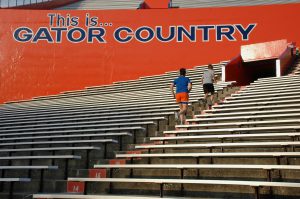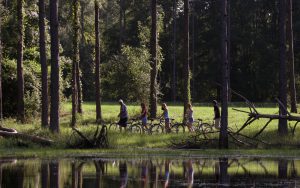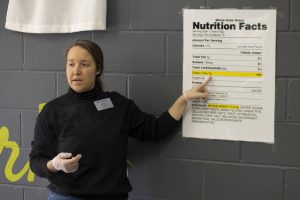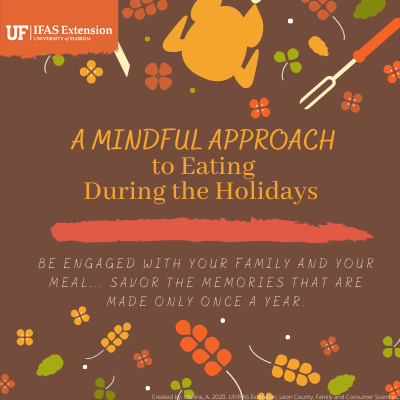
by Samantha Kennedy | Apr 4, 2022
“Stressed is just desserts spelled backwards.” When I was younger, I took this saying to heart. If I was stressed, I reached for the sweets. That instant rush of sugar to my brain provided a feeling of happiness and contentment. But it was only temporary. Once the sugar high wore off, I went back to feeling overwhelmed with stress, which just made me reach for more sweets.
It took me much too long to realize this was an endless and unhealthy cycle. Stress eating, especially stress-eating junk food, was such an ingrained habit for me, I did not even think about it having negative consequences such as weight gain and high blood sugar, both of which can be exacerbated by stress itself.
More recently, I have taken an interest in healthier coping strategies. Stress is an inevitable and integral part of our lives. We cannot avoid it. But we can seek ways to deal with it that do not add even more stress (or calories) to our body. One of the most helpful strategies I have adopted to cope with stress is to strive to live more mindfully.

Spending time in nature has been shown to decrease feelings of stress, lower blood pressure, and increase feelings of calm. (Photo source: UF/IFAS File Photo)
Mindfulness has become a bit of a buzzword over the last few years, but do not let that trick you into thinking it is just a fad. Mindfulness and everything it entails has been around for decades (even longer!). Practices such as mindful breathing, tai chi, and meditation are all part of mindfulness, which is simply an umbrella term used to describe strategies for dealing with difficult emotions, managing stress, and staying present in everyday life.
One of the things I have found most valuable in my foray into mindfulness is the ability to better recognize the signs of stress in my body. Early recognition of stress signals allows me to put one of my new mindfulness skills into practice to combat their effects. This may include simply pausing for a few moments and consciously breathing or taking a short walk in the sunshine while allowing the sounds around me, and not my stressful thoughts, to become the focus of my attention.
Another good practice for stress reduction in general is to immerse yourself in nature whenever possible. Whether that is hiking one of the many local nature trails, kayaking in the springs, or relaxing at the beach while listening to the waves, spending time in nature has been shown to alleviate stress. Even watching a brief nature video online has been shown to lower blood pressure and elicit feelings of calm.
April is Stress Awareness Month. I challenge everyone to take some time this month to really think about what stress looks like for you and how it shows up in your mind and body. How do you usually cope with it? If the answer involves over-indulgence in a substance such as food or alcohol, I urge you to try a new, healthier way to cope. Go for a walk. Focus on your breath. Even try meditation with the help of a mindfulness mobile app. It may feel weird at first, but if you keep at it, it will soon become a new healthy habit that you will reach for instead of that bag of chips.
UF/IFAS is an Equal Opportunity Institution.

by Heidi Copeland | Apr 1, 2022
 Taxes, without a doubt, can conjure up responses from elation,” Yeah! I get a refund!,” to dread…” Darn, I owe!” The Covid-19 pandemic has prompted another response…What in the heck happened to my 2019- and 2020-income tax return?
Taxes, without a doubt, can conjure up responses from elation,” Yeah! I get a refund!,” to dread…” Darn, I owe!” The Covid-19 pandemic has prompted another response…What in the heck happened to my 2019- and 2020-income tax return?
While it is quite normal for the Internal Revenue Service (IRS) to face a bit of backlog every year, according to The Washington Post, the IRS closed last year’s tax season with an unprecedented large number of returns unprocessed due to budget cuts and staff issues.
Most recently, IRS Commissioner Chuck Rettig said in a statement, “The pandemic continues to create challenges, but the IRS reminds people there are important steps they can take to help ensure their tax return and refund don’t face processing delays.”
Know that having all the information needed to file an accurate return helps the whole process and helps to avoid delays. The US 2022 (2021 tax year returns) income tax season will:
- Begin on January 24, 2022. This is the day the tax agency will begin accepting and processing 2021 tax year returns.
- The deadline to file 2021 federal taxes for most people is April 18, as April 15, Emancipation Day, is a holiday in Washington, D.C.
- Maine and Massachusetts residents have until April 19 to file their federal returns, as April 18 is Patriot’s Day in those two states.
- The deadline for filers requesting an extension is Oct. 17, 2022.
- The IRS is urging to file your tax return electronically and, if you are due a refund, to choose direct deposit.
- The IRS anticipates that most taxpayers will receive their refund within 21 days if they file electronically and choose direct deposit.
Please, do not be influenced to apply for a tax refund anticipation loan, typically known as an RAL, if you are not in an emergency for the loaned money. An RAL is a loan based on the anticipated amount of your federal income tax refund. Many tax filing services will offer you a RAL if… you file with their service. Know that your loan amount will be based on the value of your anticipated refund minus fees and/or interest charges.
Know, too, that your loan will be deposited directly to the lender once the IRS processes your income tax return. Be VERY careful with refund anticipation loans. An obvious positive attribute of the loan is you get money quickly – before the season even opens. Another benefit is that, once the lender receives your refund, the loan is paid. But what happens if your tax refund is smaller than the anticipated income tax refund? You now will have an outstanding loan that will need to be paid back.
As with many income tax seasons, there are changes to the tax code. Important changes for the 2022 income tax season include:
Standard Deduction
The standard deduction for taxpayers who do not itemize deductions on Form 1040, Schedule A, has increased. The standard deduction amounts for 2021 are:
- Married Filing Jointly or Qualifying Widow(er) – $25,100 (increase of $300)
- Head of Household – $18,800 (increase of $150)
- Single or Married Filing Separately – $12,550 (increase of $150)
Taxpayers who are 65 and Older or are Blind
For 2021, the additional standard deduction amounts for taxpayers who are 65 and older or blind are:
- Single or Head of Household – $1,700 (increase of $50)
- Married taxpayers or Qualifying Widow(er) – $1,350 (increase of $50)
Earned Income Credit (EIC)
By law, the IRS cannot issue your refund before February 15. This includes your entire refund, not just the part that’s related to the credit you claimed on your tax return. This law change, which took effect in 2017, helps ensure that taxpayers receive the refund they are due by giving the IRS more time to detect and prevent fraud. If you claimed the Earned Income Tax Credit (EITC) or the Additional Child Tax Credit (ACTC), you can expect to get your refund by the first week of March if:
- You file your return electronically
- You choose to get your refund by direct deposit
- The IRS finds no issues with your return
For 2021 only:
- More taxpayers without qualifying children can qualify for the Earned Income Tax Credit (EITC). The maximum EITC credit is nearly tripled for these taxpayers and, for the first time, is made available to both younger workers and senior citizens.
- EITC is available to both taxpayers without qualifying children and families with qualifying children. (Taxpayers filing married filing separately can claim this credit in 2021.)
- EITC can be figured using 2019 income, as long as it was higher than 2021 income. In some instances, this option will give a larger credit.
For 2021, the maximum EITC credit increased to:
- $6,728 with three or more children
- $5,980 with two children
- $3,618 with one child
- $1,502 with no children
- $51,464 ($57,414 if Married Filing Jointly) with three or more qualifying children
- $47,915 ($53,865 if Married Filing Jointly) with two qualifying children
- $42,158 ($48,108 if Married Filing Jointly) with one qualifying child
- $21,430 ($27,380 if Married Filing Jointly) with no qualifying child
Investment Income
- Taxpayers whose investment income is more than $10,000 cannot claim the EITC.
Standard Mileage
For 2021, the following rates are in effect:
- 56 cents per mile for business miles driven
- 16 cents per mile driven for medical or moving purposes
- 14 cents per mile driven in service of charitable organizations (no change)
Education Benefits
American Opportunity Tax Credit for 2021 is gradually reduced (phased out) if taxpayers’ MAGI (Modified Adjusted Gross Income) is between $80,000 and $90,000 ($160,000 and $180,000 if Married Filing Jointly). Taxpayers cannot claim a credit if their MAGI is $90,000 or more ($180,000 or more if Married Filing Jointly).
Lifetime Learning Credit for 2021 is gradually reduced (phased out) if taxpayers’ MAGI is between $80,000 and $90,000 ($160,000 and $180,000 if Married Filing Jointly). Taxpayers cannot claim a credit if their MAGI is $90,000 or more ($180,000 or more if Married Filing Jointly).
Student Loan Interest Deduction begins to phase out for taxpayers with MAGI in excess of $70,000 ($140,000 for joint returns) and is completely phased out for taxpayers with MAGI of $85,000 or more ($170,000 or more for joint returns).
Virtual Currency
The IRS announced that convertible virtual currencies, such as Bitcoin, would be treated as property and not as currency, thus creating immediate tax consequences for those using Bitcoins to pay for goods and services. Taxpayers having transactions in virtual currencies are out of scope for the VITA/TCE programs.

by Claire Davis | Jan 13, 2022

Being more active is one of the top New Year’s Resolutions.
Photo credit: UF/IFAS Photo: Sally Lanigan.
Well, it’s that time of year again. January 1st has finally rolled around and I still have not completed last year’s New Year’s Resolution. If you’re like me, your resolution is to lose weight in 2022. Maybe you have chosen to quit smoking, exercise more, or try to be more positive. Maybe these resolutions sound familiar to you because they were last year’s resolutions, too!
You don’t have a New Year’s Resolution yet? Below is a list of some of the most common New Year’s Resolutions that could help you spark an idea!
-

Exercising with others can help you stay on track to reach your wellness goals.
Photo credit: UF/IFAS Photo: Josh Wickham.
Exercise more
- Lose weight
- Get organized
- Learn a new skill or hobby
- Save more money
- Quit the use of tobacco
- Quit the use of alcohol
- Spend more time with family and friends
- Travel more
- Read more
So, how do you ensure that you are going to stick to your resolution? Below are a few New Year’s Resolution tips to help us create long-lasting change:
- Dream big! The bigger, the better. Do you want to learn to run a marathon? Do you want to fit back into those jeans you wore in high school? Being ambitious will help inspire others around you to cheer you on toward those goals.
- Break that big dream down into smaller pieces. Running 26 miles seems daunting, but when you start with just walking 1 mile, you will soon gain the confidence to push for more. Choosing to reach for healthier snacks, such as carrots or celery instead of potato chips, is a small change that can affect your diet. You do not have to deprive yourself of foods you enjoy to lose weight. You just have to focus on portion control. Small steps will move you forward to your ultimate goal.
- Commit yourself to your goals! Write them down, post your goals on social media, or verbally promise to others that you are going to do it. Hold yourself accountable to what you are trying to do. Sometimes, making a public announcement will encourage others to join you on your journey. They can push you to be the best version of yourself, while also holding you accountable.
- Give yourself a pat on the back! “Rome wasn’t built in a day.” Well, neither will you accomplish your end goal in one day. Typically, our new year’s resolutions take time, sometimes a very long time. Encourage yourself to keep going by acknowledging what you do accomplish!
- Learn from your past. I am not perfect, you are not perfect, no one is perfect! We all stumble at times, but it is how we recover that will set us up for success or failure. If you “fall off the healthy-eating train” one evening, don’t beat yourself up or give up. Tomorrow is a new day, and you can resolve to recover from your mistakes to get back on track.
- Support! I have mentioned inspiring others already, but you need support, too. Accept help from those who care about you to help you achieve your goals. Consider joining a support group, such as a workout class at the gym or a group of co-workers to quit smoking. These individuals share your struggles and want to see you succeed, which makes the challenge less intimidating!
- The 3 R’s: Reflect, Replace, and Reinforce. The 3 R’s can help you make a long-term change. Reflect on your current situation, i.e. eating habits. Replace those unhealthy habits with healthier ones. Reinforce these changes in your daily life.

Use the Nutrition Facts label to make healthy food choices.
Photo credit: UF/IFAS.
According to the American Psychological Association, “By making your resolutions realistic, there is a greater chance that you will keep them throughout the year, incorporating healthy behavior into your every day life.” The dreaded New Year’s Resolution does not have to seem unattainable. If you plan to make a New Year’s Resolution this year, limit the number of resolutions you choose so that you can focus on them. By creating new habits and making small changes, you can do anything you put your mind to!
Sources:
https://www.health.harvard.edu/staying-healthy/seven-steps-for-making-your-new-years-resolutions-stick
https://www.apa.org/topics/behavioral-health/new-year-resolutions
https://www.dhs.gov/employee-resources/blog/2020/01/07/new-years-resolutions

by Julie McMillian | Jan 13, 2022

Trees help to clean the air and provide a relaxing setting to reduce stress.
Photo credit: Anitra Mayhann
Do you know how vital trees really are? Trees conserve soil and water and clean the air. Research has shown that there are both mental and physical health benefits from forests. Trees provide us with oxygen through photosynthesis. Not to mention, think of the beauty they add to an area. Florida has celebrated Arbor Day for many years, since 1886 to be exact. It is the third Friday in January, whereas the National Arbor Day is the last Friday in April.
We can improve our health just by spending time outside in nature. Forests and trees can boost our immune system, reduce stress, increase our ability to sleep as well as boost energy levels while improving mood and helping us to focus. Studies in health care show a link between nature and health. Plants put off airborne chemicals called phytoncides to repel insects. The antifungal and antibacterial qualities that are put off in this process help us as we breathe them in by increasing our white blood cell count.
It is important that we remove ourselves occasionally from our office or home to explore green spaces to take a mental break. That might mean a walk in the forest, gardening, exercising, or resting and meditating to unplug from our fast-paced busy life. Many doctors encourage and incorporate this type of therapy for wellness for their patients and for children diagnosed with attention deficit disorder.
There are many ways to celebrate trees. They are a great gift for birthdays, holidays, or anniversaries. You might also consider planting a tree in honor of a family member who has passed on or to remember a beloved pet. This year, give a gift that gives back as well as be encouraged to celebrate Florida’s Arbor Day on January 21st, 2022.
Many holidays celebrate something we remember, but Arbor Day is a way to celebrate hope for the future by planting a tree to support a healthy community. I encourage you to check with your local government offices, Forrester, or Extension office to see if there are any special celebrations planned that you could join or plan your own activity to honor trees as a resource and how they impact your environment.
For more information, visit Arbor Day Foundation or Florida Urban and Community Forestry.

by Gretchen Thornton | Jan 13, 2022
The Art of Effective Communication
SMART Couples Florida Celebration
Statewide Virtual Event
February 19, 2022
6:00 – 9:15 p.m. EST

Photo source: Victor Harris
It’s time to talk about love! Join us online for a night of real talk about building stronger relationships from marriage and family professionals across the nation. Learn how to improve your communication and keep the romance alive. Tickets available now!
Learn more here: https://smartcouples.ifas.ufl.edu/flcelebration/

by Amy Mullins, PhD, RDN | Nov 24, 2021
The holiday season is finally upon us. It’s a time for enjoying family, friends, and food!
You can make healthy habits this holiday season. It’s not only a single meal but rather an entire season of parties, events, gatherings festivities, and unhealthy choices that add up to that holiday weight gain we resolve to lose when January rolls around. As the holiday season begins its rapid approach, take time and consider those eating habits that set your new year off on the wrong foot. Why not make a resolution now to eat healthier this holiday season?
Just a few simple strategies can help make the difference and keep those unwanted pounds away. Here are some suggestions:
- Don’t skip meals. Eating healthy on a regular basis will keep you from overindulging at holiday gatherings.
- Use smaller plates for meals and gatherings and be mindful of portions
- Choose more vegetables and smaller helpings of entrees and desserts
- Drink more water and minimize alcoholic drinks and eggnog
- Make healthier recipe ingredient substitutions when cooking and baking
Take a mindful approach to keeping your personal health goals in-check. We can all still experience the joy of the holiday season, without making food the focus. Make a resolution to be mindful and eat healthier this holiday season, and your waistline will thank you!
 Learn more about making healthy habits this holiday season!
Learn more about making healthy habits this holiday season!
— Tips for Making Healthy Choices
— Simple Substitutions
— Diabetes During the Holidays
— How to Add Fruits and Veggies
— Cranberry Nutrition
— Cranberry Sauce Recipe
— Holiday Food Safety Tips
Click here to read the newsletter.














